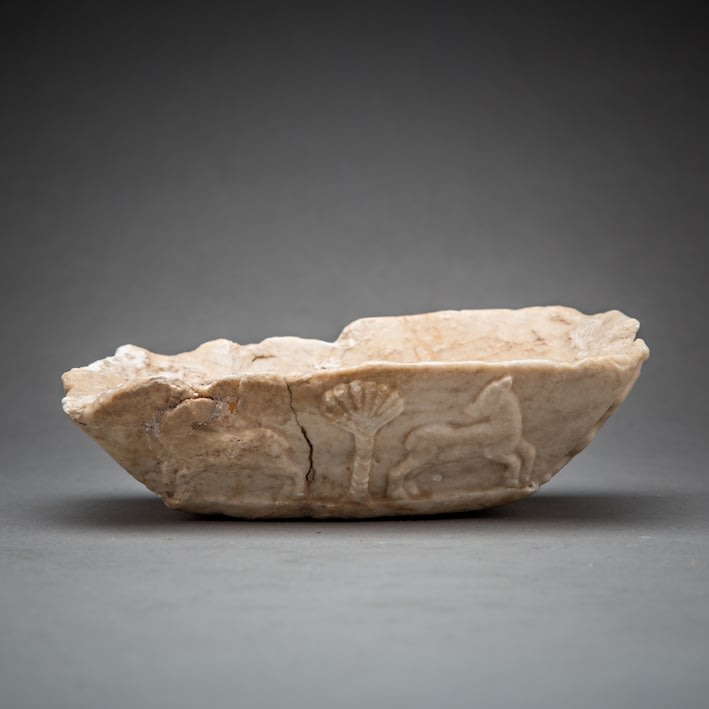Sumerian Trapezoid stone vessel, 2500 BCE - 1500 BCE
stone
16.5 x 5.1 cm
6 1/2 x 2 in
6 1/2 x 2 in
HB.007
Further images
Boat-shaped Short sides: man with spear held with two hands against lion in the salient position. On the opposite side, a panel with a four-line cuneiform inscription. Long-sides: violent scene...
Boat-shaped Short sides: man with spear held with two hands against lion in the salient position. On the opposite side, a panel with a four-line cuneiform inscription.
Long-sides: violent scene of a lion attaching a large hoofed animal, possibly a cow, in opposition to the pastoral serenity of the other side, with two calves in heraldi The lion standing erect in profile to the left standing on both hind legs braced apart, with raised forepaws. This is the most common position for a carnivorous quadruped when attackin Lions had a significant role in numerous ancient cultures. In the near east area a long line of cultures used the motif of lion as both a symbol of primal and royal power. The earliest examples come from Mesopotamia. This usage continued throughout the later cultures of the Hittites, Babylonians, Assyrians, Persians and early Islamic cultures like the Umayyads and Abbassids.
In antiquity, lions were common along the southern coast of the Mediterranean, as well as in Greece and the Middle East. In Greek mythology lions appear in a variety of functions. The Lion Gate of Mycenae features two rampant lionesses who flank a central column representing the ruling power of this early Greek culture, dating at 13th century BC. According to the Book of Genesis of the Hebrew Bible, the Israelite Tribe of Judah had the Lion of Judah as its symbol.
The characteristic of the lion as the "king of the jungle" goes back to the influence of the Physiologus, an early Christian book about animal symbolism which spread into many cultures and generally had great influence in Western culture. First written in Greek in the 2nd century AD, the book was translated into Latin in about 400 AD, next into Ethiopic and Syriac, then into many European and Middle Eastern languages. Many illuminated manuscript copies such as the Bern Physiologus survive. It retained its influence over ideas of the "meaning" of animals in Europe for over a thousand years. It was a predecessor of bestiaries (books of beasts). Medieval poetical literature is full of allusions that can be traced to the Physiologus tradition; the text also exerted great influence on the symbolism of medieval ecclesiastical art.
Long-sides: violent scene of a lion attaching a large hoofed animal, possibly a cow, in opposition to the pastoral serenity of the other side, with two calves in heraldi The lion standing erect in profile to the left standing on both hind legs braced apart, with raised forepaws. This is the most common position for a carnivorous quadruped when attackin Lions had a significant role in numerous ancient cultures. In the near east area a long line of cultures used the motif of lion as both a symbol of primal and royal power. The earliest examples come from Mesopotamia. This usage continued throughout the later cultures of the Hittites, Babylonians, Assyrians, Persians and early Islamic cultures like the Umayyads and Abbassids.
In antiquity, lions were common along the southern coast of the Mediterranean, as well as in Greece and the Middle East. In Greek mythology lions appear in a variety of functions. The Lion Gate of Mycenae features two rampant lionesses who flank a central column representing the ruling power of this early Greek culture, dating at 13th century BC. According to the Book of Genesis of the Hebrew Bible, the Israelite Tribe of Judah had the Lion of Judah as its symbol.
The characteristic of the lion as the "king of the jungle" goes back to the influence of the Physiologus, an early Christian book about animal symbolism which spread into many cultures and generally had great influence in Western culture. First written in Greek in the 2nd century AD, the book was translated into Latin in about 400 AD, next into Ethiopic and Syriac, then into many European and Middle Eastern languages. Many illuminated manuscript copies such as the Bern Physiologus survive. It retained its influence over ideas of the "meaning" of animals in Europe for over a thousand years. It was a predecessor of bestiaries (books of beasts). Medieval poetical literature is full of allusions that can be traced to the Physiologus tradition; the text also exerted great influence on the symbolism of medieval ecclesiastical art.







